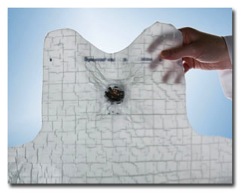
Development of improved protective fabrics starts with effective materials research.
Part I of this article (“Better ballistics, Part I”) looked at the ballistics market for advanced textiles, the materials typically used in ballistic textile products, and some of the textiles and textile composites now being developed for lighter weight and more comfortable ballistics protection. A variety of new materials and processes are either available currently or are in development.
Newer materials
Milliken & Co., Spartanburg, S.C., contributes Tegris™ polypropylene (PP) thermoplastic composite to the arsenal of ballistic textile technologies. Tegris technology is based on a co-extruded PP tape yarn with a highly drawn core sandwiched between layers of lower-melt polymer.
According to Milliken, for ballistics applications layers of fabric are stacked. Using only heat and pressure, the outer layers melt and fuse the stack together into flat panels and molded parts that have very good impact properties. The composite, used in combination with metals, ceramics and other composites for hard armor, enables considerably reduced weight compared with glass-filled composites and at a lower cost than the premium composites.
Simpsonville, S.C.-based Innegrity LLC offers Innegra™ S PP-based ballistic materials for both hard- and soft-armor applications. The company says it has developed economical, effective hybrid solutions combining Innegra S with aramids and is in the process of testing it with UHMWPE fibers. He noted that in testing, soft-armor panels containing a 50/50 blend of Innegra S and aramid provide practically the same level of protection as aramid alone. In hard armor—especially heavy, inches-thick armor—the performance of blends containing from 25 to 75 percent Innegra S equals or exceeds that of aramid alone for a lower cost, in addition to lowering the fabric weight by 10-20 percent.
Developing technologies
A lot of ballistic textile research and development is conducted at the U.S. Army Natick Soldier Research, Development and Extension Center, Natick, Mass. (SRDEC), in collaboration with fiber and ceramics companies, academic institutions and other entities, with a goal of developing ever lighter-weight, higher-performance materials that can improve soldiers’ mobility, performance and comfort.
Mechanical engineering research at the SRDEC has learned that there are mechanical fiber properties that can be used to predict the performance of a fiber in an armor system before the fiber exists. This is done in part knowing some fiber manufacturers have a processing envelope for treating the fibers. The SRDEC can tell the fiber makers the fiber it would prefer, but the center is still working on ways to understand what would make a better fiber using that model.
In one project, Natick is working with the University of Cambridge, England, and Concord, N.H.-based Nanocomp Technologies Inc., producer of long carbon nanotubes (in the millimeter length range) in yarn and nonwoven sheet form. According to Nanocomp, the materials are 100 times stronger than steel, extremely lightweight, and easier and safer to handle than commercially available powdery carbon nanotubes.
Nanocomp currently is producing small amounts of carbon nanotube yarn and nonwoven sheet materials in its research-scale facility. The company says the materials will have applications in composite systems for use in strike and spall layers, plate and compressed materials such as helmets, or in layered hybrid systems. It will make it possible to expand the protected area without increasing weight or compromising mobility. The materials have demonstrated a higher level of fracture toughness than traditional ballistic textile materials, as well, and are ultraviolet resistant, flame resistant and immune to moisture.
At North Carolina State University, Raleigh, N.C., high-tenacity polyethylene naphthalate (PEN) fibers in development under the direction of researchers show potential for both soft and hard ballistic applications. The fibers are melt-spun using a newly developed process and at 12.5 grams per denier are reported to be the strongest polyester fibers ever made. According to a researcher working on the project, a hybrid sample made with high-tenacity PEN woven and hydroentangled nonwoven fabrics is lighter-weight and shows higher ballistic performance than a PEN woven fabric.
Fort Mill, S.C.-based Kuraray America Inc.’s Vectran® liquid crystal polyarylate fiber is not traditionally used in ballistic applications. However, a new version of the high-strength, high-cut- and impact-resistant fiber is in development for uses in military hard armor, according to the company’s Vectran Division.
Ballistic undergarments
A recent development in ballistic end products is ArmorWorks’ PUG, part of the Pelvic Protection System, which was designed to address the danger that soldiers confront with ground-based IED threats. The PUG is worn next to the skin to protect the pelvis, femoral arteries, and lower abdominal organs in a blast or fragmentation event. The PUG will also help reduce the penetration of dirt and fine debris into a wound area thus aiding in infection prevention. The undergarment has a breathable, moisture-wicking material on the outer thighs, knitted Kevlar is along the inner thighs to protect the fleshy inner parts of the thighs and the femoral artery, and over the groin, there is more knitted or woven Kevlar.
Exactly where ballistic materials and end products will go next will depend on many factors, but it’s clear that new and more effective products will continue to be developed and are likely to contribute to a robust market in the future.
Andrew D. Park is principal consultant with PTI Consulting, Ashburn, Va., with specific expertise in military ballistics materials. Part II of this article will run later in December. It will discuss newer materials and technologies in the ballistics market.
 TEXTILES.ORG
TEXTILES.ORG


